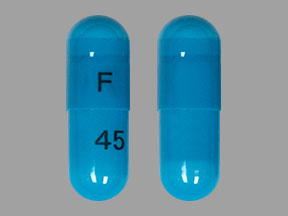Atomoxetine Disease Interactions
There are 9 disease interactions with atomoxetine.
- Narrow angle glaucoma
- Cardiac disease
- Glaucoma
- Hypertension
- Psychiatric disorders
- Liver disease
- Renal dysfunction
- Seizure disorders
- Urinary retention
Atomoxetine (applies to atomoxetine) narrow angle glaucoma
Major Potential Hazard, High plausibility. Applicable conditions: Glaucoma (Narrow Angle)
The use of atomoxetine is contraindicated in patients with narrow angle glaucoma. In clinical trials, atomoxetine use was associated with an increased risk of mydriasis.
CNS stimulants (applies to atomoxetine) cardiac disease
Major Potential Hazard, Moderate plausibility. Applicable conditions: Heart Disease, Pheochromocytoma, Hyperthyroidism, Peripheral Arterial Disease
Many CNS stimulants are contraindicated in patients with significant cardiovascular impairment such as uncompensated heart failure, severe coronary disease, severe hypertension (including that associated with hyperthyroidism or pheochromocytoma), cardiac structural abnormalities, serious arrhythmias, etc. Sudden death has been reported in patients with structural cardiac abnormalities or other serious cardiac disease who are treated with CNS stimulants at the recommended dosages for attention deficit hyperactivity disorder; use of these agents should be avoided in patients with known structural cardiac abnormalities, cardiomyopathy, serious cardiac arrhythmia, coronary artery disease, or other serious cardiac disease. Additionally, stroke, myocardial infarction, chest pain, syncope, arrhythmias, and other symptoms have been reported in adults under treatment. A careful assessment of the cardiovascular status should be done in patients being considered for treatment. This includes family history, physical exam, and further cardiac evaluation (EKG and echocardiogram). Patients who develop symptoms should have a detailed cardiac evaluation and if needed, treatment should be suspended.
CNS stimulants (applies to atomoxetine) glaucoma
Major Potential Hazard, Moderate plausibility. Applicable conditions: Glaucoma/Intraocular Hypertension
The use of most CNS stimulants is contraindicated in patients with glaucoma, as these agents exhibit sympathomimetic activity and may induce mydriasis provoking an increase in intraocular pressure.
CNS stimulants (applies to atomoxetine) hypertension
Major Potential Hazard, Moderate plausibility.
CNS stimulants increase blood pressure and heart rate; the use of some agents may be contraindicated in patients with severe/uncontrolled hypertension. Caution should be used when administering to patients with preexisting high blood pressure (even mild hypertension) and other cardiovascular conditions. All patients under treatment should be regularly monitored for potential tachycardia and hypertension.
CNS stimulants (applies to atomoxetine) psychiatric disorders
Major Potential Hazard, Moderate plausibility. Applicable conditions: Psychosis, Depression
The use of CNS stimulants can cause psychotic symptoms, suicidal ideation, and aggression, and can exacerbate symptoms of behavior disturbance and thought disorder; CNS stimulants may induce a manic or mixed episode in patients with bipolar disorder. Psychiatric symptoms have been reported in patients with and without history of psychiatric disorders. All patients (particularly those with psychotic or bipolar disorders) should be monitored closely, especially during treatment initiation and at times of dose changes. Extreme caution should be exercised when CNS stimulants are given to patients with a history of psychosis, depression, mania, or bipolar disorder. Prior to initiating therapy, all patients should be screened for risk factors for developing a manic episode (e.g., comorbid or history of depressive symptoms or family history of suicide, bipolar disease, or depression). If any psychiatric symptoms emerge or are exacerbated, treatment suspension should be considered. Some CNS stimulants are contraindicated in patients with marked agitation or anxiety.
CNS stimulants (applies to atomoxetine) liver disease
Moderate Potential Hazard, Moderate plausibility.
In general, CNS stimulants are extensively metabolized by the liver. Their plasma clearance may be decreased and their half-life prolonged in patients with impaired hepatic function. Therapy with CNS stimulants should be administered cautiously in patients with moderate to severe liver disease, and the dosage should be adjusted accordingly in certain agents. Additionally, postmarketing reports have shown that atomoxetine can cause severe liver injury; laboratory testing should be done at the first sign/symptom of liver dysfunction (jaundice, dark urine, upper quadrant tenderness) and treatment should be discontinued in patients with evidence of liver injury.
CNS stimulants (applies to atomoxetine) renal dysfunction
Moderate Potential Hazard, Moderate plausibility.
Overall CNS stimulants should be administered with caution in patients with significantly impaired renal function as the reduction in the rate of elimination may alter the therapeutic response. The dosage should be adjusted accordingly in certain agents.
CNS stimulants (applies to atomoxetine) seizure disorders
Moderate Potential Hazard, Moderate plausibility. Applicable conditions: Seizures
Due to general central nervous system stimulation, therapy with CNS stimulant drugs may cause seizures. These drugs may lower the convulsive threshold in patients with history of seizures, with prior electroencephalogram (EEG) abnormalities without seizures, and very rarely, without history of seizures and no prior EEG evidence of seizures. Therapy with CNS stimulants should be used with caution in patients with or predisposed to seizures. If seizures occur, therapy should be discontinued.
Atomoxetine (applies to atomoxetine) urinary retention
Minor Potential Hazard, Moderate plausibility.
There have been reports of urinary retention and urinary hesitation in ADHD patients using atomoxetine. Caution should be used if any urinary symptoms appear, especially in patients with history of urinary disorders.
Atomoxetine drug interactions
There are 340 drug interactions with atomoxetine.
Atomoxetine alcohol/food interactions
There are 2 alcohol/food interactions with atomoxetine.
More about atomoxetine
- atomoxetine consumer information
- Check interactions
- Compare alternatives
- Pricing & coupons
- Reviews (630)
- Drug images
- Side effects
- Dosage information
- During pregnancy
- Drug class: adrenergic uptake inhibitors for ADHD
- Breastfeeding
- En español
Related treatment guides
Drug Interaction Classification
| Highly clinically significant. Avoid combinations; the risk of the interaction outweighs the benefit. | |
| Moderately clinically significant. Usually avoid combinations; use it only under special circumstances. | |
| Minimally clinically significant. Minimize risk; assess risk and consider an alternative drug, take steps to circumvent the interaction risk and/or institute a monitoring plan. | |
| No interaction information available. |
Further information
Always consult your healthcare provider to ensure the information displayed on this page applies to your personal circumstances.


